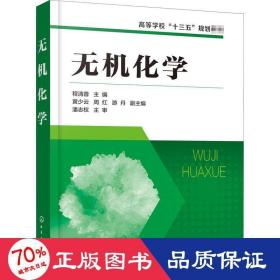
无机化学 大中专理科化工 陆家政 新华正版
¥ 37.35 7.6折 ¥ 49 全新
库存4件
作者陆家政
出版社化学工业出版社
ISBN9787122062505
出版时间2018-09
版次1
装帧平装
开本16
页数307页
字数529千字
定价49元
货号xhwx_1201737524
上书时间2024-12-14
- 最新上架
商品详情
- 品相描述:全新
- 正版特价新书
- 商品描述
-
目录:
ⅰ inorganic chemistry1
chapter 1 introduction2
1.1 observations and conclusions3
1.2 the scientific method3
1.3 units of measurement5
1.4 advice on studying chemistry8
key words8
chapter 2 structures of atoms9
2.1 particles in atoms10
2.2 the bohr model12
2.3 the wave theory of electrons13
2.4 heisenbergs uncertainty principle14
2.5 the schrer equation14
2.6 quantum numbers15
2.7 shapes of atomic orbitals17
2.8 many-electron atoms19
2.9 valence electrons24
2.10 the periodic table and electronic configurations of atoms24
2.11 the periodicity of the properties of elements and atomic structure26
key words30
exercises31
chapter 3 chemical bonds33
3.1 ionic bonds33
3.2 covalent bonds35
3.3 lewis dot symbols and lewis structure37
3.4 sigma and pi bonds43
3.5 bond polarity44
3.6 bond energy, bond length and bond angle45
3.7 molecular geometry47
3.8 the vsepr model47
3.9 hybrid orbitals51
3.10 molecular orbitals56
3.11 intermolecular force64
key words71
exercises71
chapter 4 thermochemistry74
4.1 first law of thermodynamics74
4.2 enthalpy and enthalpy change75
4.3 hesss law76
4.4 entropy and the second law of thermodynamics 79
4.5 spontaneous processes and gibbs free energy80
4.6 temperature and direction of spontaneous change81
4.7 standard free energy of formation and standard free energy of reaction82
key words83
exercises83
chapter 5 chemical kiics85
5.1 reaction rates85
5.2 theories of reaction rates 87
5.3 effect of concentration on rate of reaction89
5.4 rate and temperature92
5.5 catalysis94
key words95
exercises96
chapter 6 chemical equilibrium98
6.1 concept of equilibrium98
6.2 equilibrium constant98
6.3 le chteliers principle103
key words106
exercises106
chapter 7 solutions108
7.1 ways of expressing concentration108
7.2 colligative properties113
key words124
exercises125
chapter 8 solubility equilibrium127
8.1 saturated solutions and solubility127
8.2 solubility equilibria127
8.3 factors affecting solubility130
8.4 predicting precipitation reaction132
8.5 selective precipitation134
8.6 application of precipitate on medicine137
key words138
exercises139
chapter 9 acid-base equilibria141
9.1 acids and bases141
9.2 ion product of water143
9.3 strength of weak acids and bases144
9.4 the ph of weak acids and bases146
9.5 the mon-ion effect148
9.6 buffer solutions150
key words153
exercises153
chapter 10 an introduction to electrochemistry155
10.1 odation-reduction reactions155
10.2 balancing odation-reduction equations158
10.3 voltaic cells161
10.4 standard cell electromotive force164
10.5 electrochemistry and thermodynamics171
10.6 effect of concentration on cell emf172
10.7 reduction potential diagrams of elements(latimer diagrams)174
key words177
exercises177
chapter 11 chemistry of coordination pounds180
11.1 the history of coordination chemistry180
11.2 formation of coordination pound182
11.3 nomenclature of coordination pounds184
11.4 structure and isomerism 185
11.5 coordination equilibrium in solution187
11.6 valence bond theory of coordination pounds191
11.7 the crystal field theory194
11.8 the biological effects of coordination pounds199
key words200
exercises201
chapter 12 nonmetals and semimetals203
12.1 general concepts203
12.2 hydrogen203
12.3 boron204
12.4 the group ⅳa elements,the carbon group elements205
12.5 the groupⅴa elements,the nitrogen group elements208
12.6 the group ⅵa elements,the oxygen group elements211
12.7 the group ⅶa elements,the halogens215
12.8 the group ⅷa elements,the noble gases218
key words218
exercises219
chapter 13 metals 220
13.1 the group ia elements220
13.2 the group ⅱa elements224
13.3 the group ⅲa elements229
13.4 a survey of transition metals232
13.5 chemistry of some transition metals234
key words239
exercises239
ⅱ inorganic chemical experiments241
chapter 1 basic techniques of experimental chemistry242
1.1 safety242
1.2 recor results243
1.3 weighing243
1.4 concerning liquids244
chapter 2 typical chemical laboratory apparatus 252
chapter 3 experiments254
3.1 some elementary operation254
3.2 acid-base titration256
3.3 electrolyte solutions259
3.4 preparation of officinal sodium chloride and its purity examination 262
3.5 odation-reduction reactions267
3.6 coordination pounds271
3.7 the halogens275
3.8 chromium,manganese and iron278
3.9 copper,silver,zinc and mercury283
3.10 determination of the ionization constant of hac by ph meter287
3.11 preparation of ammonium iron(ⅱ)sulfate291
3.12 preparation and content determination of zinc gluconate294
appendix296
reference
内容简介:
无机化学针对药学类专业无机化学的双语课程,将无机化学课程的基本内容进行精选,结合靠前高校实际,删除原版教材中大量的复杂、繁琐及较深奥的部分,力求使之既能体现无机化学课程的专业基础课特,又可提高的英语应用能力。
鉴于医药学专业理论与实验课程并重的特点,全书包含两大部分:ⅰ inorganic chemitry与ⅱ inorganic chemical experiment。part ⅰ inclu thirteen chapter:1 introduction2 tructure of atom3 chemical bond4 thermochemitry5 chemical kiic6 chemical equilibrium7 olution8 olubility equilibrium9 acidbae equilibria,10 an introduction to electrochemitry11 chemitry of coordination pound12 nonmetal and emimetal13 metal。part ⅱ inclu three chapter:1 baic technique of experimental chemitry2 typical chemical laboratory apparatu3 experiment。
无机化学可作为高等院校本科药学及化学类相关专业的无机化学双语教材,也可作为化学专业英语课的教材或参书。
相关推荐
-

无机化学实验 大中专理科化工
九五品保定
¥ 15.00
-

无机化学 大中专理科化工 秦川 主编
全新北京
¥ 16.05
-

无机化学 大中专理科化工 陆家政
全新北京
¥ 36.05
-

无机化学 大中专理科化工 秦川 主编 新华正版
全新保定
¥ 19.03
-

无机化学 大中专理科化工 陈玉凤 主编
全新北京
¥ 28.55
-

无机化学基础 大中专理科化工 陈艳 编
全新北京
¥ 9.35
-

无机化学 大中专理科科技综合 刘云霞 编
全新北京
¥ 28.45
-

无机化学 第2版 大中专理科化工 作者
全新北京
¥ 36.65
-

无机化学实验 大中专理科化工 林俊杰 编
全新北京
¥ 7.45
-

无机化学 大中专理科化工 程清蓉 编
全新北京
¥ 28.35
— 没有更多了 —













以下为对购买帮助不大的评价